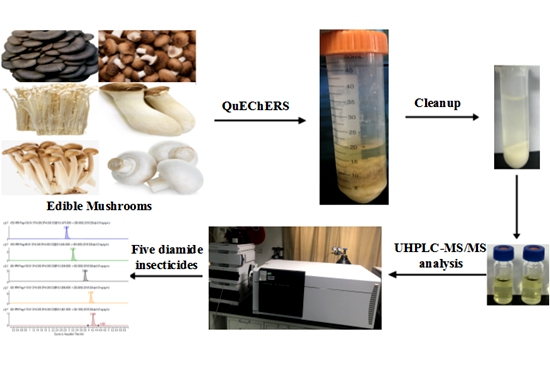Development and Validation of a Method for the Analysis of Diamide Insecticides in Edible Mushrooms
China is the world’s largest producer and exporter of edible mushrooms. Because the production process of edible mushrooms is carried out in a humid and closed environment with invisible light, diseases and insect pests have always been one of the main factors affecting the production and quality of edible mushrooms. Diamide is a novel class of insecticides with unique target site activity ,which exhibits remarkable selectivity and low toxicity to mammals. Up to now, some diamide active ingredients have been registered in different countries for pest control. Meanwhile, cyclaniliprole and tetrachlorantraniliprole are in the process of being registered on a global scale and approved for use in pest control. The maximum residue limits (MRLs) for diamide insecticides (10 μg kg−1) except for tetrachlorantraniliprole in edible mushrooms were stipulated by European Union (EU). In order to establish the MRLs of tetrachlorantraniliprole in edible mushrooms Xie Hanzhong’s lab from Zhengzhou Fruit Research Institute, CAAS has conducted the study of developing a rapid, reliable and effective analytical method for detection of diamide insecticides residues

Schematic diagram of the detection process of diamide insecticides
In this study, a new method for simultaneous determination of diamide insecticides (cyantraniliprole, chlorantraniliprole, tetrachlorantraniliprole, cyclaniliprole and flubendiamide) in edible mushrooms was established by high-performance liquid chromatography coupled to tandem mass spectrometry (HPLC-MS/MS) combined with a modified QuEChERS procedure. The determination of these insecticides could be completed in less than 5 min by this method. The limits of detection and quantification were 0.05–2 μg kg−1 and 5 μg kg−1, respectively. Acceptable recoveries (73.5–110.2%) were acquired for these insecticides with RSDs less than 12.7%. The sensitivity and accuracy of the established method were better or equal to those of the previously reported methods. And this is the first report on the application of QuEChERS method to the determination of five diamide insecticides residues in edible mushrooms by HPLC–MS/MS. The results has been published in the Food Chemisry (IF: 6.306).This work was supported by the Agricultural Science and Technology Innovation Program (Grant CAAS-ASTIP-2019-ZFRI-10), the Central Public-interest Scientific Institution Basal Research Fund (No. 1610192020106), and the Quality and Safety Risk Assessment for Agro-Products of China (Grant GJFP 2019041).
The URL for this article should be:
http://https://www.sciencedirect.com/science/article/pii/S0308814620313303
By Tian Fajun (tianfajun@caas.cn)
-
 Apr 18, 2024Opening Ceremony of the Training Workshop on Wheat Head Scab Resistance Breeding and Pest Control in Africa Held in CAAS
Apr 18, 2024Opening Ceremony of the Training Workshop on Wheat Head Scab Resistance Breeding and Pest Control in Africa Held in CAAS -
 Apr 03, 2024IPPCAAS Co-organized the Training Workshop on Management and Application of Biopesticides in Nepal
Apr 03, 2024IPPCAAS Co-organized the Training Workshop on Management and Application of Biopesticides in Nepal -
 Mar 28, 2024Delegation from the School of Agriculture and Food Science of University College Dublin, Ireland Visit to IAS, CAAS
Mar 28, 2024Delegation from the School of Agriculture and Food Science of University College Dublin, Ireland Visit to IAS, CAAS -
 Mar 25, 2024Director of World Food Prize Foundation visited GSCAAS
Mar 25, 2024Director of World Food Prize Foundation visited GSCAAS -
 Mar 20, 2024Institute of Crop Sciences (ICS) and Syngenta Group Global Seeds Advance Collaborative Research in the Seed Industry
Mar 20, 2024Institute of Crop Sciences (ICS) and Syngenta Group Global Seeds Advance Collaborative Research in the Seed Industry
